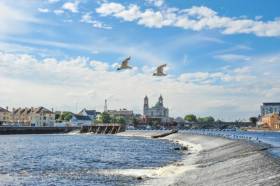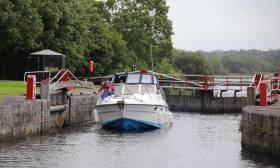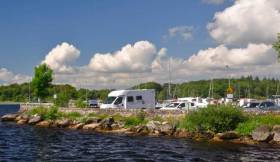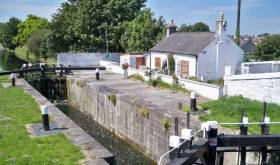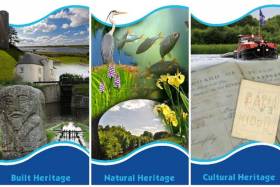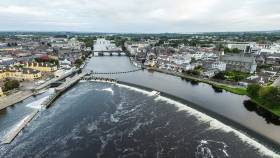Displaying items by tag: Waterways Ireland
#InlandWaters - Mike Palmer of the UK’s Waterway Recovery Group has been announced as a keynote speaker at the World Canals Conference in Athlone this September.
Chair of Britain’s national co-ordinating body for voluntary labour on inland waterways, Palmer will address the conference on the topic of ‘Waterways in Progress - the Waiting Gain’ — how restoration schemes are not just a means to an end, and can bring quantifiable benefits at every stage of their development.
Palmer is the latest of a growing list of keynote speakers to open the three-day conference at the Radisson Blu Hotel Athlone from Monday 10 to Wednesday 12 September under the theme ‘Restoring, regenerating, re-imagining’.
Delegates will also be welcomed by the two-day Shannon ‘Feastival’ on Saturday 8 and Sunday 9 September, with Athlone hosting boat tours to taste a range of food and crafts made by local artisans.
The deadline for early bird discounts has been extended to next Friday 15 June to benefit from up to 20% off the cost of registration.
Special prices are also available for accommodation on board a luxury hire cruiser before, during and after the conference, as previously reported on Afloat.ie.
Smart Cards for Lock Passages on River Shannon, Waterways Ireland Rolls Out New Service
Waterways Ireland is extending its Smart Card system to include lock passages on the River Shannon and Lower Bann.
The service will be tested from a technical perspective at Albert Lock on the Shannon and the Cutts Lock on the Lower Bann for a two week period beginning on the 16th of April 2018. Following the technical test period and depending on the learnings taken from it, Waterways Ireland will then begin the roll out of Smart Card usage at all locks and lifting bridges on both the Shannon and Lower Bann. Marine Notice 15/2018 has been issued to this effect.
The Smart Card is already in use along the Shannon for numerous services including showers, toilets, pump-outs and electricity and on the Shannon-Erne Waterway for lock passages. The extension of the service to include lock passages will mean a one-stop-shop for waterway customers for all waterway services. The customer provides their Smart Card to the Lock-keeper to insert into a reader which deducts the units for the lock passage. The lock-keeper will then operate the lock as usual.
The pilot at Albert Lock will run from the 16th – the 30th April 2018 and boats will have the following payment options – use their existing Smart Card, pay in cash or purchase a Smart Card. Many boaters already have Smart Cards as they use them to purchase other services along the Shannon. Hire boat companies already provide the Smart Cards to their customers. Boaters can buy Smart Cards from local retailers or order online– the list of retailers is available from www.shopwaterwaysireland.org.
The remaining Shannon locks and bridges will accept payment by smart card and cash from the 1st May until the end of June 2018. From the 1st July – 30th September 2018 boaters presenting with case will be able to buy a smart card from the Lockkeeper. From 1st October payment will be by Smart Card only and the boater will need to have a valid card on board. Where bridge lifting is required at Tarmonbarry and Rooskey, a combined toll payments for the lock and bridge will be taken at the Lock.
The cost of the lock passage on the Shannon will remain the same and will take two units from the smart card. The cost of the lock passage on the Lower Bann will be 1 unit. The lock passage on the Shannon-Erne Waterway will remain at 1 unit. The 10 unit card cost €6.35/£5.55 and the 20 unit card €12.70/£11.10.
Waterways Ireland has managed over 1000km of waterways since 1999, investing significantly in improving services and facilities along the navigations including mooring, services blocks, creating and extending boating destinations along the Shannon including Killaloe, Garrykennedy, Dromineer, Ballyleague, Carrick-on-Shannon, Boyle, and Lough Key.
Further information on the pilot and the smart card system can be found by emailing [email protected].
Revised Opening Hours For Shannon-Erne Waterway In 2018
#InlandWaters - Waterways Ireland has announced revised opening hours for the locks on the Shannon-Erne Waterway for 2018.
From next Thursday 29 March to Wednesday 16 May, locks will open from 9am to 6pm daily, extending to the full summer season opening hours of 9am to 8pm from Thursday 17 May till Wednesday 12 September.
In the late season, daily openings of 9am to 6pm are set for Thursday 12 September till Wednesday 31 October, dates and times to be confirmed. Winter hours will be advised towards the end of the season.
These changes apply seven days a week. The changes in operating hours will be seen in the early and late shoulder seasons only, and reflect usage patterns recorded by Waterways Ireland.
Throughout the season a minimum of two water patrollers will be working along the waterway to ensure that customer services can be provided as swiftly as possible.
For more information contact the SEW Operations Team in Carrick-on-Shannon at 071 965 0642.
Flooding at Many Inland Harbours
Waterways Ireland advises masters, owners and the general public that recent rains have caused flooding at many harbours making them unsafe for pedestrian and vehicular traffic in the immediate surrounds of the harbour infrastructure. Banagher, Shannon Bridge, Mountshannon, Scarriff and Limerick harbours are severely effected.
In particular, harbour and jetty edges and access points cannot be seen due to flood water, making it dangerous to attempt to approach these facilities until the flooding has receded
Waterways Ireland Recruiting Inspector Of Navigation
#Jobs - Waterways Ireland is currently recruiting for an Inspector of Navigation based in Athlone, and an engineer based in Dublin.
The Inspector of Navigation will be responsible for a number of strategic work areas, including the monitoring and management of navigational and recreational activities on all of the navigations; enforcement of bye-laws; inspection of aids to navigation and acting as marine safety adviser for the organisation.
The inspector will be responsible for the management of inspectorate staff and will work closely with senior managers and colleagues in operations to deliver business objectives.
They will also represent Waterways Ireland at national and international level, pro-actively promoting the interests of all stakeholders, and the navigational and recreational remit of Waterways Ireland.
Inspectorate staff are based in each of Waterways Ireland Operational Regions, Western, Northern and Eastern, and work as part of the management and operational teams in these regions.
The Inspector of Navigation is based in Athlone and is part of the Western Region Operations team. In addition, the Inspector of Navigation provides a central management support to all inspectorate staff across their regions.
Further details of the role and how to apply can be found on the Waterways Ireland website. The closing date for applications is Monday 29 January.
The Engineer (Operations) will form part of an operational management team and will oversee management/maintenance, recreational/commercial use and future development of Waterways Ireland infrastructure within the Dublin metropolitan area, as required.
The successful applicant will be required to manage operational staff and consultants/contractors working on Waterways Ireland property for implementation of new or refurbishment projects, co-ordinate with user groups for facilitation of events, and work in partnership with third parties and local interests to manage and develop the canals for increased recreational use.
More details of the role and how to apply are available on the Waterways Ireland website. The closing date for applications to this position is Monday 5 February.
Application Time For Waterways Ireland 2018 Event Programme
#InlandWaters - The Waterways Ireland 2018 Event Programme is open for 2018 and welcoming applications from waterways and waterside communities seeking support to start and grow sustainable events.
Taking place annually for the past 12 years, the programme has supported competitions, learning experiences, community, historical and educational events for people with and without disabilities across thousands of communities nationwide.
Involving angling, canoeing, rowing, sailing and power sports, arts, history, drama, learning new skills, these events have most importantly been about having fun.
Sharon Lavin, head of marketing and communications with Waterways Ireland, says: “The new vision for the Event Programme will activate event organisers to consider how they can build in ongoing activity and sustained use of the waterways corridors into their event.
“Tourism and participation in recreation has a social and economic impact in waterfront communities, and events are a great way to engage communities with previously under-utilised waterways.”
Applications must now be made online. The guidance notes can be viewed and application form completed online at the Waterways Ireland website. Terms and conditions apply.
The closing date the receipt of completed applications is Monday 22 January.
Waterways Ireland is the recreation and navigation authority for the Barrow Navigation, Erne System, Grand Canal, Lower Bann Navigation, Royal Canal, Shannon-Erne Waterway and the Shannon Navigation.
New Lease Of Life For Royal Canal Lock House
#RoyalCanal - In news you may have missed from this year, the first lock house on the Royal Canal in Dublin is set for a new lease of life.
A familiar sight for locals and commuters in the city’s North Strand district, the cottage by Newcomen Bridge has been out of use for a number of years since its last residents, the Lynch family, moved on after four decades.
Now Waterways Ireland says it’s to be taken over by The Adventure Project, a city-based non-profit that runs adventure therapy programmes for addiction services, crime diversion projects and young people in care.
It’s expected that the cottage will become a base for a new canal adventure programme, making use of an already lively inland waterway amenity.
Waterways Ireland Heritage Plan Open Day Next Week
#InlandWaters - Waterways Ireland is hosting its second annual Heritage Plan Open Day from noon to 7pm next Wednesday 13 December at its headquarters in Enniskillen, Co Fermanagh.
Visitors can review all the actions of the Heritage Plan that were progressed in 2017, as well as meet staff from the various divisions within Waterways Ireland to chat face-to-face about potential projects, ideas and support the cross-border body can offer stakeholders in Ireland’s inland waterways.
Come and listen to oral histories, inspect archival material and discuss waterway place names. Sit down and review the wide variety of natural, built and cultural heritage reports commissioned throughout the year.
View the work undertaken by the recipients of the 2017 Heritage Grants Scheme. Staff will be on hand to advise on the 2018 Grants Scheme, too.
Talk to Waterways Ireland about potential projects you’d like progressed in 2018, partnerships you can offer or general queries about the Heritage Plan.
Waterways Ireland’s chief executive Dawn Livingstone will also be present on the day, with eight dedicated slots for one-to-one meetings available to reserve via Doodle.
Have your say in the ‘What Floats your Boat’ public feedback corner where you can leave a comment on what you like or where you think Waterways Ireland could improve our service to our stakeholders.
There will also be free boat trips (spaces allocated on a first come, first served basis) from the Waterways Ireland HQ moorings from 1-3pm.
Take one of two one-hour boat tours of Enniskillen and Devenish Island, or try your hand at a Menapii currach with Row the Erne, winners of the Living Waterways National Award (weather dependant).
Limited parking is available at the Waterways Ireland HQ, which is also accessible on foot from the town centre.
Athlone To Host World Canals Conference Next September
#InlandWaters - Waterways Ireland and the Inland Waterways Association of Ireland will host the World Canals Conference 2018 in Athlone next September on the shores of Ireland’s longest waterway, the River Shannon.
‘Restoring, regenerating, re-imagining’ is the theme of the three-day conference from 10-12 September at the Radisson Blu Hotel Athlone that will feature various tours and sessions designed to inspire and connect delegates from all over the globe.
Register soon for to take advantage of the early bird rates ranging from €345 to €385. Some conference tours also have limited numbers so book early to secure your preferred tour and discount.
Special prices are also available for accommodation on board a luxury hire cruiser before, during and after the conference.
Cruisers can be booked for four to 14 nights, with four nights’ free mooring at the full service marina adjacent to the conference venue for the first 10 bookings.
For prospective conference speakers, the organisers are inviting abstract submissions till 28 February 2018 within the remit of the theme across the engineering, tourism, recreation, health and well-being, communications, technology, and arts and heritage sectors.
For more on the event, visit the World Canals Conference 2018 website or sign up for the newsletter for regular updates.
Waterways Ireland Archive Exhibition in Mullingar Celebrates 200 Years of the Royal Canal
#RoyalCanal - A forthcoming exhibition in Mullingar Library will celebrate 200 years of the Royal Canal through images and drawings from the Waterways Ireland archive.
Featuring a selection of images from the archive and from the Ruth Delany and Ian Bath Collections, the exhibition reveals the fascinating history of the Royal Canal over the past 200 years.
The photographs on display are a snapshot of the long history of the inland waterway but they are also testament to the work and efforts of individuals like Ruth Delany and Ian Bath to personally document its deterioration from the 1970s onwards and to highlight an awareness of the canal during the years of lobbying for support for its restoration.
The exhibition will be on display in Mullingar Library from next Monday 27 November to Friday 8 December during library opening hours:
Monday 10am to 5:30pm
Tuesday 10am to 8pm
Wednesday 11am to 5.30pm
Thursday 10am to 8pm
Friday 10am to 5pm
Saturday 10am to 1.30pm


























